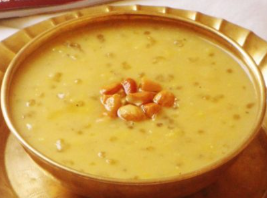Recipe credit: Darshana Muzumdar
Serves 4 as part of a traditional Indian meal.
In the traditional version the whole moong beans are roasted till they start to pop and then they are cooked. Many contemporary cooks use moong dal without roasting it instead.
Ingredients
- 1 cup whole green gram or whole moong (or ¾ cup moong dal)
- ¼ cup sago or sabudana (tapioca starch balls)
- ½ coconut (around 1 cup when grated/scraped)
- ½ cup jaggery or as per taste
- 10-15 cashew nuts broken into small pieces
- A handful or ¼ cup finely slivered coconut pieces
- 5-6 cardamoms powdered
Method
- Rinse the sago once and drain it. Add enough water to just about cover it. Soak it for 4-6 hours.
- After the water is absorbed completely, separate the sago balls gently with your fingers and keep them aside ready to use.
- Roast the whole moong till it begins to split. If you are using split moong instead of the whole moong to begin with, roast it till it starts changing color and becomes light brown.
- Soak the roasted moong in water for 15-20 minutes and then cook in boiling water till it is soft. You can pressure cook it for 3 whistles to hasten the process. If you are using moong dal, do not roast it before cooking it.
- Bring ¾ cup of water to bring to a boil and add the sabudana in it. Cook it till the sabudana is soft and translucent.
- In the meantime, grate the coconut and grind it very fine with just enough water to help the blades of the blender move.
- Pour this fine mixture into a damp muslin cloth placed over a pot and squeeze the milk out. This should yield about 1 cup.
- Add the cooked sabudana, jaggery and coconut milk to the cooked moong and continue to cook it on a low flame.
- Add the powdered cardamom, cashew nut pieces, and slivered coconut pieces.
- Continue to cook on a low flame until it begins to thicken.
- Remove from heat and serve hot, cool or at room temperature. If it is cooled in a refrigerator, you may need to use more jaggery to get the same sweetness.
For the Whole-Food Plant-Based (WFPB) version:
Use date paste instead of jaggery. Simply blend the dates with a little water to make the paste. If the dates are not soft, soak them for 2-12 hours depending on how hard they are. They can also be cooked and then blended for this recipe.
Use a little soaked brown rice instead of the sago (less than ¼ cup).
Use the entire finely ground fresh coconut without straining it instead of the coconut milk. In fact, many people used this traditionally instead of the strained coconut milk.
Note: Personally, I like this sweet dish made without roasting the moong beans and is my all time favorite dessert when made with moong dal instead of whole moong. It has more roughage with the green skin on and will be WFPB, but the moong dal boon tastes much better in my opinion.
Share this:
- Click to share on Facebook (Opens in new window)
- Click to share on WhatsApp (Opens in new window)
- Click to share on Twitter (Opens in new window)
- Click to share on Pinterest (Opens in new window)
- Click to share on LinkedIn (Opens in new window)
- Click to share on Reddit (Opens in new window)
- Click to share on Tumblr (Opens in new window)
- Click to share on Pocket (Opens in new window)
- Click to share on Telegram (Opens in new window)
- Click to print (Opens in new window)

